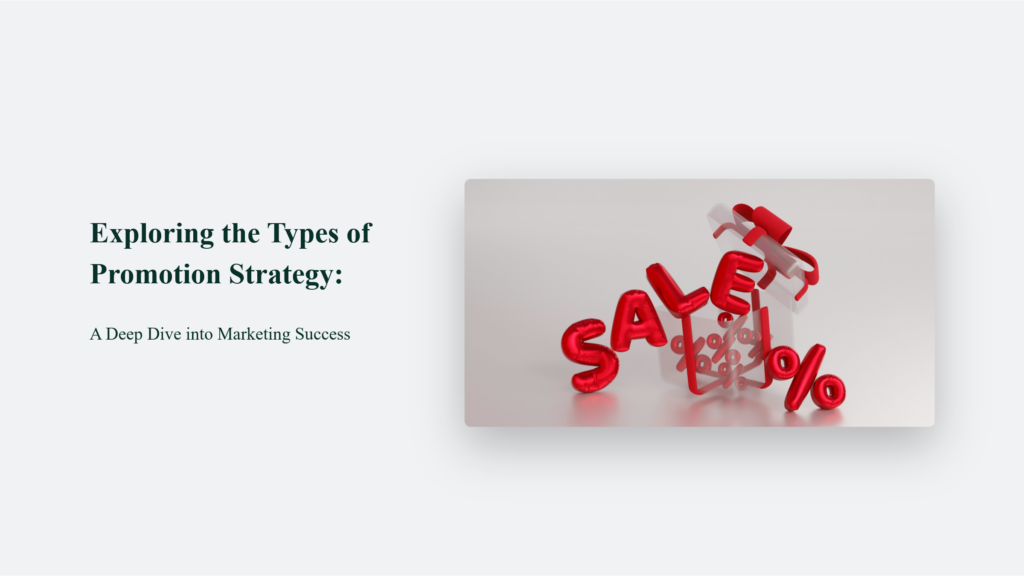In the ever-evolving marketing world, grasping the varied types of promotion strategy can feel akin to navigating a labyrinth. Whether you’re a seasoned marketer or a budding entrepreneur, the right promotional strategy can dramatically amplify your brand’s voice and sales figures.
Let’s explore these strategies with analytical precision and personal insights, unveiling how they can transform challenges into opportunities.

Understanding Promotion Strategies
Promotion strategies are the heartbeats of marketing campaigns, pumping life and visibility into products and services. These strategies aim to connect, persuade and ultimately convert the audience into loyal customers. But how do we choose the right one?
Key Types of Promotion Strategy
Promotion strategies are essential tools in the marketer’s arsenal, each with unique benefits and applications. Here’s a closer look at five core strategies that can transform the trajectory of a brand.
Advertising: The Art of Persuasion
Advertising is the quintessential promotion strategy, omnipresent and potent. It’s about crafting messages that resonate widely, from towering billboards to digital pop-ups. The magic of advertising lies in its ability to reach a vast audience repeatedly, embedding a brand into the collective consciousness.
For example, Coca-Cola’s “Share a Coke” campaign is a prime illustration. It personalised soda cans with popular names, inviting consumers to find cans with their names or those of their friends. This brilliant strategy personalised the experience and spurred a global sharing frenzy, significantly lifting sales in 70 countries. It shows how advertising can turn a simple idea into a worldwide sensation.
Public Relations: Crafting a Positive Image
Public Relations (PR) is all about nurturing a brand’s image and cultivating a strong relationship with the audience. Unlike traditional advertising, PR often leverages media and community engagements to build trust and goodwill. A standout instance of effective PR is when Lego responded to a letter from a 7-year-old who had lost his favourite mini-figure.
Lego replaced the missing figure and sent additional figures with a personalised story, turning a routine customer service interaction into a viral tale of exceptional customer care. It delighted the young fan and enhanced Lego’s image as a caring and responsive company.
Sales Promotions: Immediate Incentives
Sales promotions are tactical, often temporary, and used to spur immediate increases in sales. This strategy includes discounts, coupons, buy-one-get-one-free offers, and similar tactics designed to drive short-term consumer excitement and urgency.
The annual phenomena of Black Friday and Cyber Monday are perfect examples of where sales promotions play a pivotal role. Retailers offer dramatic discounts not typically available throughout the year, creating a buzz consumers eagerly anticipate and participate in en masse.
Personal Selling: The Human Touch
Personal selling is a direct strategy that relies on individual interactions to influence purchase decisions. This approach is particularly prevalent in industries where relationships and detailed information are critical, such as pharmaceutical sales or high-end B2B environments.
A friend in pharmaceutical sales once shared how customising her approach for each doctor—focusing on patient benefits and tailored data rather than a generic pitch—increased acceptance and use of the drugs she promoted. This strategy hinges on connecting personally, understanding the customer’s needs, and providing solutions that resonate individually.
Direct Marketing: Targeted and Personal
Direct marketing engages customers through more personal channels, such as emails, direct mail, or targeted online advertising. This method is highly effective in reaching specific demographics with tailored messages. Netflix’s approach to direct marketing through personalised personalised email recommendations based on viewing habits is a testament to its power.
By analysing viewer data to predict what customers might enjoy watching next, Netflix keeps existing customers engaged and significantly reduces churn rates. This strategy showcases how direct, personalised communication can increase customer retention and satisfaction.
Each promotion strategy offers distinct advantages and can be combined to create a comprehensive, effective marketing campaign. By judiciously understanding and implementing these strategies, businesses can enhance visibility, connect meaningfully with their audience, and drive substantial growth.
Embracing Digital: A Modern Twist on Promotion Strategies
Social Media Marketing: Connecting on Every Click
Social media marketing is one of the most dynamic and impactful approaches to digital promotions. Platforms like Facebook, Instagram, Twitter, and LinkedIn offer businesses a direct line to potential customers. The key to success here is engagement. Content that resonates with users tends to perform better, which means businesses need to speak their audience’s language—sometimes literally but always culturally.
For example, Dove’s “Real Beauty Sketches” campaign leveraged emotional storytelling to challenge beauty stereotypes, resulting in widespread media coverage and significantly increased engagement across social media platforms. This campaign boosted brand image and demonstrated how aligning brand values with consumer beliefs can amplify engagement and loyalty.
Content Marketing: The Art of Storytelling
Content marketing takes this idea further by creating and distributing valuable, relevant, consistent content to attract and retain a clearly defined audience. This strategy aims to drive profitable customer action through articles, blogs, videos, and podcasts that help establish the brand as a thought leader in its niche.
A prime example is HubSpot, a platform that offers tools for inbound marketing and sales.
HubSpot’s blog covers everything from basic marketing concepts to in-depth software tips, helping to educate its audience while also drawing them deeper into the HubSpot ecosystem. This educational approach helps build trust, essential for converting readers into customers.
Leveraging Influencer Partnerships
The startup case in point here used influencer partnerships to dramatic effect. By collaborating with influencers with established audiences, the startup could tap into these communities and promote its brand through trusted voices. Influencers bring authenticity to the table—when they recommend a product, their followers are likelier to take notice because of a pre-existing trust and rapport.
The mechanics of this strategy are straightforward but need to be executed with care:
- Identifying the right influencers involves more than looking for high follower counts; relevance to the brand’s niche and audience alignment is crucial.
- Crafting a compelling message: The influencer’s endorsement should feel natural and genuine. It must align with their usual content to avoid alienating their audience.
- Tracking and optimising: Using analytics to track engagement and conversions from influencer posts is vital for understanding the ROI and refining future campaigns.
The Outcome: Rapid Community Growth
The startup’s decision to employ influencer partnerships doubled its online community in just six months. This growth wasn’t just in numbers but also in engagement rates and brand loyalty—key metrics that signify a healthy and active community.
Conclusion:
Promotion strategies are not just tools but bridges that connect products to consumers. Choosing the right strategy involves understanding your market, budget, and brand identity. Whether through the nostalgic tug of a well-placed ad or the personalised touch of direct marketing, these strategies shape how the world sees—and buys—your products. In the dynamic dance of marketing, your promotions may be elegant and bold, propelling your brand to new heights.
Frequently Asked Questions:
What is the most cost-effective promotional strategy?
Content marketing and social media can be highly cost-effective, particularly for startups.
How do I measure the success of my promotional strategy?
Key performance indicators (KPIs) like sales volume, website traffic, and conversion rates are essential metrics.
Can small businesses compete with big brands in terms of promotion?
Absolutely! Digital platforms level the playing field, allowing small businesses to achieve substantial reach with lower budgets.




